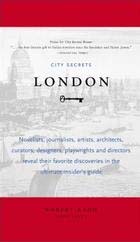
Standing in front of the shelves marked “London” in my local bookseller, I already knew I was in trouble. I was planning to write a quick survey of London travel guides but faced with hundreds of titles, and with no developed criteria for selection, I ended up sitting for two days in the basement of Nomad Books, a good independent bookstore with an excellent travel section, going through their inventory. It was a daunting experience. Of course, the usual suspects were there: Fodors, Lonely Planet, Rough Guide, Insight, Time Out and Michelin Green Guides, but so were the guides for every variety of person or interest: London for Children, for Grannies, for Gays and Lesbians, for Food Lovers, for Teenagers, for Design Freaks and Shoppers. I began to wonder how one city, even a city as vast and varied as London, could support the 1,712 guides which I found on Amazon.
After two days at Nomad and countless hours on Amazon, I’ve tried to boil my survey down to the following observations:
There is not a huge difference amongst the big players.
Yes, Lonely Planet, Rough Guide, Michelin Green guides, Insight, Fodors and Time Out have probably worked hard to differentiate themselves but from an information perspective, they all do a good job of providing lots of background and detail, covering the sights, accommodations, shopping opportunities and restaurants in different price categories and neighbourhoods. They all provide good summaries of the city’s history and stuff that is useful to know when you are planning your visit. They all cost more or less the same thing, somewhere in the range of £10/$18.50. They may think they are different, but they do pretty much the same thing. Once you start drilling down, you can make your selection based on criteria such as:
If you want lots of good graphics and visuals – Go for either DK Eyewitness or the AA Key Guide
If you like consistent rating systems – Go for Michelin Green Guides or Fodors
If you want your guide to have some energy and attitude – Go for Lonely Planet, Rough Guide or Time Out. If you don’t like ads in your guidebooks, feeling as I do that paying full freight for the book is enough, then Lonely Planet is the way to go.
The London e>>guide offers on-line updates but I went online and saw nothing special about the website. This format also promotes the use of podcasts as part of self-guided walking tours, a topic that I would like to explore in a subsequent post.
Many of the main providers also offer stripped down or condensed versions such as Lonely Planet’s “Best of London” and Time Outs “Shortlist” but I would argue that unless you are an absolute fanatic about the weight and size of what you carry around, there is no real reason to buy these formats. Go for the full monty and make your own selection.
The specialists guides rarely seem worth what they cost or weigh in your daypack.
I plowed through them all, Grannies, Lesbians, Children, Food Lovers, Museum Lovers, Design Lovers and more and found most either fall back on the same information that can be found in the comprehensive guide (just arranged differently) or suffer from annoying formats or amateurish production values, or are loaded with ads. Most are too limited to rate the real estate or weight they would claim in your day pack.
In general, I think Time Out does the best job of slicing and dicing their stock of information for London into specialist formats such as Time Out “Eating and Drinking”, “Health and Fitness” “Shopping” “Students” and “Gay and Lesbian”.
But as a rule of thumb, when in doubt, go for a comprehensive guide from a major provider and slice and dice according to your own interests and whims.
There are exceptions to every rule.
If I were to go to London with only one book in my bag, it would be the tiny City Secrets - London edited by Robert Kahn which is a highly subjective, wonderful little book about London written by contemporary novelists, artists, playwrights, curators, poets, architects and others of similar status. Like a typical guidebook, City Secrets divides London into neighbourhoods, sometimes reporting on a major monument or popular restaurant but also providing a massive amount of quirky, idiosyncratic and useful information. It is also the most beautifully written of all the guides.
For example, the section on Hyde Park covers the Serpentine and Albert Memorial but also provides a useful piece about how to find and participate in the softball game which has been played by expatriates Americans opposite the Knightsbridge Barracks for more than 40 years (April to October). And as many times as I have been to Osterley Park, before I read City Secrets, I never knew that both Thomas Jefferson and John Adams had been turned away in 1786 for their failure to acquire tickets in advance – even in the 18th century it pays to call ahead.
There is a surprising amount of information packed into this tiny book. Many would say it is no substitute for a proper guidebook, but when I was last in Rome, the only book in my bag was City Secrets - Rome and I was delighted with the way this book helped us discover the city. If you want to see London through the eyes of articulate people who know and love this town, for my money, City Secrets London is all you will need.

No comments:
Post a Comment